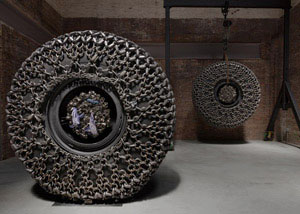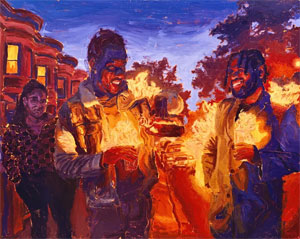Shoot to Kill
John Haberin New York City
Arthur Jafa and Alexander Brewington
A lone man steps out of a taxi, walks into a dark, narrow space, takes aim with both hands, and shoots to kill. One can hear as well as see the impact and hear without seeing the cries.
His Mohawk haircut announces his savage intentions—and the racism of a man who thinks he knows who are the savages. His victims have no time to ask. I'm going to get him, a voice repeats between agony and hope, only to add himself to the toll of the dead. Yet he, too, has had his shot, and the killer comes at last to a rest, with a bloody hand and his face close to a smile. He has come for a teenage girl who takes no comfort in her rescue. She breaks down in tears of fear or pain, leaning over the remaining source of light, in what could well be votive candles. 
Yet this is a brothel, not a church, and the scene closely follows the violent ending of Taxi Driver, by Martin Scorsese, with Robert DeNiro as the driver and Jodie Foster as the girl. Only here it starts over from the moment it is done. What was once a horrible resolution has become a nightmare, with all a nightmare's compulsion to repeat. It could belong to Scorsese or to anyone, but first and foremost to Arthur Jafa, So does his decision to recast every part but DeNiro's and Foster's with African American actors—and DeNiro's haircut with a Mohawk. The two-gallery show picks up in Tribeca for a long walk through another narrow corridor and the blackness.
Jafa titles the video with a row of asterisks, like something unprintable. This artist spells out no more than he must, while articulating the feelings of others. In the past he has wrapped a huge tire in chains, but he is not just out to run you over. He titles the second installation (with its typo), Black Power Tool and Die Trynig. He brings irony to his own hopes for black power, and he knows what it means to die. He knows, too, when to walk away—and, as a postscript, Alexander Brewington, takes African American art to New York at night the old-fashioned way, in paint.
To kill, to dream, or to die
Jafa saw Taxi Driver as a teenager, and the shock awakened him to a life in moving images, as a cinematographer and then a video artist. Few could have known what to expect in 2016 in heading way west in Harlem for Love Is the Message, the Message Is Death. A collage of found footage of black life, it had no need of reshooting. Its rapid-fire rhythms showed one triumph or tragedy after another, in sports, in politics, in popular entertainment, and at the hands of police. And each one left the victor on the point of exhaustion or death. If Black Lives Matter, they must survive on the edge of blackness.
It has become an exhibition staple for good reason. Jafa could be revisiting its theme and its collage every since—and I invite you to catch up with my past reviews for a fuller picture of the artist. He returned to that much-missed Harlem factory space two years later for a still darker and choppier history, spanning preachers, a lynching, and the trial of a sex worker. She could almost be Jodi Foster, except that Foster is in tears and white. And that points to a feature of the new video that threatens to overshadow the rest. What changes when its cast becomes black?
Jafa notes that the screenplay for Taxi Driver, by Paul Schrader, already had the shooting victims as black before Scorsese overruled him. Is this, then, an act of restitution or disfigurement, and is it recovering the film's true racism or its challenge? In the film, the taxi driver cruises Times Square, where African American street life passes in a blur of artificial lights with nary a voice. Now the taxi driver's righteousness may find its mirror in the viewer, as he mows down black criminals. It may find its mirror in the headlines as well, with mass shootings by loners and racists. No wonder Schrader had to admit that, were Taxi Driver filmed as he wrote it, it would have caused a riot.
The press has taken the answers as obvious, but are they? They come down to the awful heritage of race in America, even as theorists call race meaningless and the grandchildren of immigrants become accepted as white. They come down, too, to race in the hands of an artist who takes nothing for granted apart from its ability to disturb. So it is again—only this time he comes closest to photo-collage in the second gallery, where the only break in the stillness is you. Photographs line the inside of a Plexiglas enclosure and, outside it, on the gallery walls. And that enclosure is black.
Most of the photos show blacks, and most show musicians or street disturbances, but not all, and just try to recognize them. You may feel lost among friends and saviors that you only wish you knew. The maze itself may put you in mind of rusted steel sheets from Richard Serra. Remember the threats and comforts that they offer. Metal scraps at eye level, some painted black or red, could come right out of Minimalism as well—like an actual die. This is both black and white history, on the streets and in art, but not all are created equal.
Can it work without a video's rhythms and with ever so many unknowns? I cannot swear either way, but at least a partial answer lies in repetition and disturbance. The nightmare's cuts and camera angles play out the same way each time, but with additions. Once the scene starts with the brothel keeper, lingering over a smoke, and once the scene ends with a police officer, his gun held over the killer's heart. If he cannot pull the trigger, could you? Are y
Start the fire
African American art has never looked better. The sheer amount of portraiture today reflects the wealth of possibilities and its increasing acceptance in the galleries. With the Dean collection at the Brooklyn Museum, the Obama state portraits, or such artists as Henry Taylor at the Whitney, one can almost take it for granted or as a right. More than ever, too, that acceptance extends to black abstraction. Sam Gilliam, Melvin Edwards, and William T. Williams are no longer a niche or in need of recovery, but at the very center of the action—to the point that such younger artists as Odili Donald Odita and Diedrick Brackens have to fight for space. Even apart from photography, video, echoes of Africa, and overtly political art, here all art is both personal and political.
So at least runs one decent enough story, but consider another. Actual political art is shunted aside, because too many artists I do not care to name cannot get off their high horse. Portraiture looks less and less real and less human because they cannot let go of the glitter. They are so proud of their identity that the tensions inherent in the label are kept behind the tapestry and shoveled under the rug. They are painting not individuals now, but icons.  They may pull their subjects from the street, but the fire of the streets is gone.
They may pull their subjects from the street, but the fire of the streets is gone.
Could both stories be true? If so, it could attest after all to a vibrant, thought-provoking state of the art. At least one young artist is back on the streets as well. He is also challenging himself and others as to who owns the streets and who gets to enjoy them. At the end of the day, and Alexander Brewington loves the night, he and his friends can stand tall and take it easy. Hey, they didn't start the fire.
In "What Burns Beneath," the streets sure look familiar. Black or white, you can recognize the trains as New York and the entrance to the Williamsburg Bridge as a landmark. Inside, well-stocked bars could make anyone feel at home. Those walking the streets or hanging out for a drink might already be your friends. At the very least, they look like individuals. Warm-weather coats and frank expressions replace fine art's idea of street clothes.
Then again, it can be hard to name the streets and harder still to call them a community. Fresh from his MFA at Pratt, Brewington is walking Manhattan, including midtown Manhattan, where not everyone can afford a drink. Even with the Chrysler Building visible at the end of a street, I could not pin down the neighborhood. Two friends share drinks at one bar, but others at the window are looking in, perhaps never to arrive. So much for Brooklyn or Harlem with their true communities, although stone row houses may equally well belong to them.
At the same time, the fire has spread. Paint on board has visible highlights dribbling along the edges. Less explicable pools of yellow and orange cluster and rise, from the pavement or in windows, whether as comforts or as threats. While two men seem to be warming their hands, in Flambé, the flames may or may not be real. Others might want to keep their distance. It is all part of life in the city.

Arthur Jafa ran at Barbara Gladstone through May 4, 2024, and at David Zwirner/52 Walker through June 1, Alexander Brewington at Thierry Goldberg through March 16. A related review looks at several past shows by Arthur Jafa.




